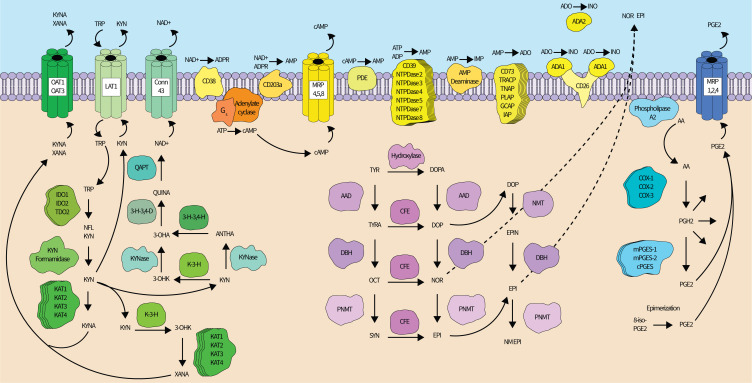Figure 1.
The redundant synthesis networks of immunosuppressive metabolites. Kynurenine pathway (left—green). After being imported into a cell by amino acid transporters, tryptophan is oxidized by one of three enzymes—IDO1, IDO2, or TDO2—to n-formyl-L-kynurenine, which is then converted to kynurenine by formamidases. Kynurenine may exit the cell through the LAT1, which simultaneously imports tryptophan, or continue down the kynurenine pathway until converted into xanthurenic acid (XANA) (major route) or nicotinamide adenine dinucleotide (NAD+) (minor route). Four different kynurenine aminotransferase (KAT) enzymes can transaminate kynurenine into kynurenic acid. Alternatively, kynurenine can be converted into 3-hydroxy-kynurenine by kynurenine 3-hydroxylase (K-3-H), or into anthranilic acid by kynureninase. 3-hydroxy-kynurenine may be converted to XANA (by KATs) or 3-hydroxyanthranilic acid (3-OHA) by kynureninase. 3-OHA may also be produced from anthranilic acid by 3-hydroxyanthranilic acid 3,4-hydroxylase (3 H-3,4-H). 3-OHA is converted into quinolinic acid by 3-hydroxyanthranilic acid 3,4-dioxygenase (3 H-3,4-D), and quinolinic acid phosphoribosyl transferase mediates the conversion of quinolinic acid to NAD+. XANA and kynurenic acid can be transported out of the cell by the OAT1 and OAT3, while connexin 43 allows NAD+ transport. Adenosine synthesis pathways (top center—yellow): adenosine synthesis occurs extracellularly in the tumor microenvironment and can use either ATP or NAD+ as a pathway substrate. ATP (or ADP to a lesser extent) can be dephosphorylated by CD39 or 6 other NTPDases into AMP. NAD+ can be converted to AMP directly by CD203a or through an ADP ribose (ADPR) intermediate by CD38 (followed by conversion to AMP by CD203a). AMP can also be generated from cAMP. cAMP is synthesized from protein Gs-activated adenylate cyclase from ATP. Intracellular cAMP can be excreted through multidrug resistance proteins 4, 5, or 8 into the extracellular space where a family of ecto-phosphodiesterases convert cAMP into AMP. AMP is finally dephosphorylated to adenosine by six possible enzymes, most prominently CD73. Adenosine can be deaminated to produce inosine by adenosine deaminase 1 (ADA) (membrane-attached via CD26) or 2. AMP can also be deaminated into IMP by AMP deaminase, and IMP can be dephosphorylated by CD73 to generate inosine (not shown). (Nor)epinephrine synthesis pathways (bottom center—magenta): schematic adapted from Molinoff and Axelrod. Epinephrine synthesis begins with tyrosine (TYR) and typically proceeds through L-dopa, dopamine (DOP), and norepinephrine (NOR) intermediates, though a parallel biosynthetic pathway exits. (Nor)epinephrine are exported through an undetermined mechanism. Prostaglandin E2 synthesis pathways (right—Blue): phospholipase A2s cleave AA from the inner leaflet of the cell membrane. Free AA is converted to PGH2 by the cyclooxygenase enzymes (COX-1, COX-2, and in the brain, COX-3). PGH2 is then converted to PGE2 by mPGES-1, mPGES-2, or cPGES (or p23), though PGH2 is also a precursor for several other prostaglandin derivatives (indicated by multiple reaction arrows stemming from PGH2 into the cytosol). PGE2 can also be generated when 8-iso-PGE2 undergoes epimerization. PGE2 is exported by MRP 1, MRP 2, or MRP 4. All proteins are denoted by text within shapes while metabolites are free-floating text. Straight lines indicate an enzyme catalyzed reaction, curved lines indicate transport or are drawn for clarity, and curved dotted lines indicate an undetermined transport mechanism. Stacked proteins indicate the existence of more than one enzyme capable of performing the indicated metabolic reaction. Up to 19 phospholipase enzymes exist in mammals, but only 1 is shown for clarity. 3-OHK, 3-hydroxykynurenine; AA, arachidonic acid; AAD, aromatic acid decarboxylase; ADO, adenosine; ANTHA, anthranilic acid; cAMP, cyclic AMP; CD, cluster of differentiation; CFE, catecholamine-forming enzyme; cPGES, cytosolic prostaglandin E synthase; DBH, dopamine-beta-hydroxylase; EPI, epinephrine; GCAP, germ cell alkaline phosphatase; IDO, indoleamine 2,3-dioxygenase; IAP, intestinal alkaline phosphatase; IMP, inosine monophosphate; INO, inosine; KYNA, kynurenic acid; KYN, kynurenine; KYNase, kynureninase; LAT, L-type/large neutral amino acid transporter; mPGES, microsomal PGE synthase; MRP, multidrug resistance-associated protein; NFL KYN, N-formyl-L-KYN; NM EPI, N-methyl epinephrine; NMT, non-specific methyltransferase; NTPDase, ectonucleoside triphosphate diphosphohydrolase; OAT, organic ion transporter; OCT, octopamine; PDE, phosphodiesterase; PGH2, prostaglandin H2; PLAP, placental alkaline phosphatase; PNMT, phenylethanolamine-N-methyltransferase; QAPT, quinolinic acid phosphoribosyl transferase; QUINA, quinolinic acid; SYN, synephrine; TDO, tryptophan 2,3-dioxygenase; TNAP, tissue-non-specific alkaline phosphatase; TRACP, tartrate-resistant acid phosphatase; TRP, tryptophan; TYRA, tyramine.

